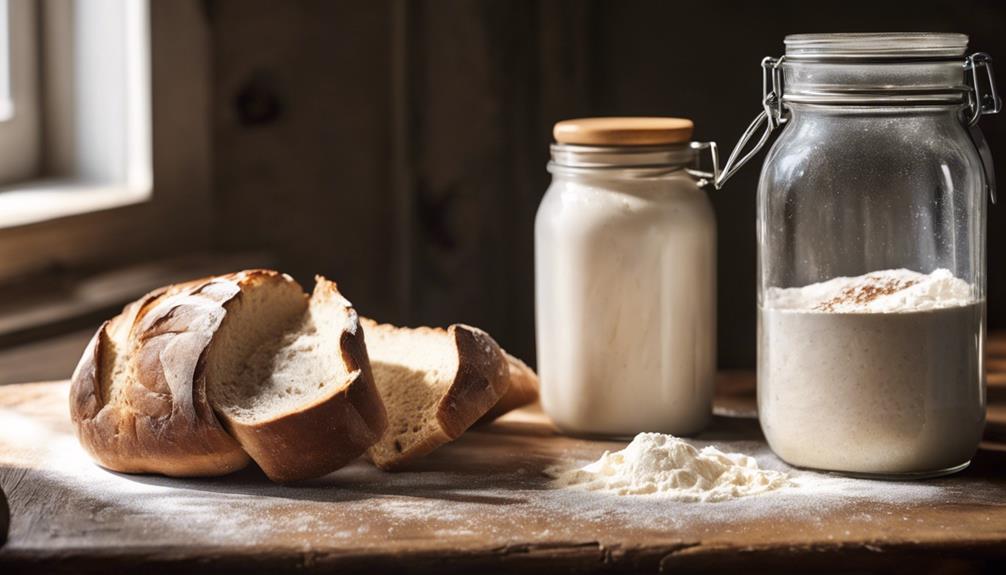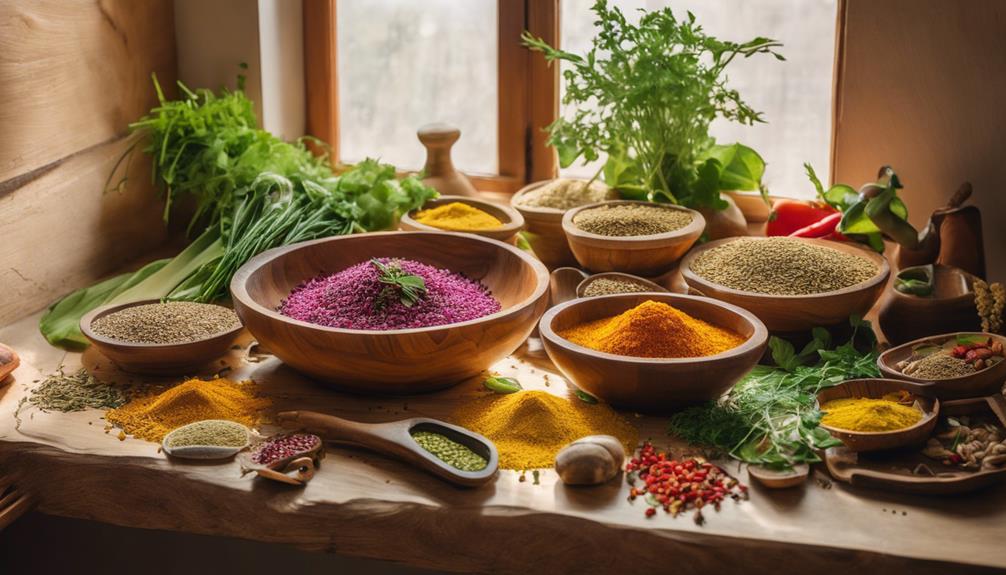How To: Fermenting Techniques For Sourdough Bread

To master Fermenting Techniques For Sourdough Bread, you’ll want to focus on wild yeast and lactic acid bacteria. Start by creating a strong starter, using high-quality flour and maintaining a consistent feeding schedule. Experiment with long fermentation for complex flavors, or opt for short fermentation if you’re short on time. Incorporate the stretch and fold technique to enhance gluten development. Remember, temperature control is vital for ideal yeast activity. Pay attention to hydration levels for the best dough texture. There’s much more to explore that can elevate your baking skills and enrich your sourdough experience.
Understanding Sourdough Fermentation
Sourdough fermentation is a fascinating process that transforms simple ingredients into a tangy, flavorful bread. You might be surprised to learn that this method dates back thousands of years, with a rich sourdough history that showcases how humans have harnessed natural fermentation to create nourishing food. Unlike commercial yeast, sourdough relies on wild yeast and bacteria present in the environment, which means you’re engaging with a living culture every time you bake.
Understanding the basics of fermentation science is essential for successful sourdough bread. When you mix flour and water to create your starter, you’re providing the perfect environment for wild yeast and lactic acid bacteria to thrive. These microorganisms consume the sugars in the flour, producing carbon dioxide and organic acids in the process. The carbon dioxide gas gets trapped in the dough, causing it to rise, while the acids contribute to the characteristic tang of sourdough.
As you nurture your starter, you’ll notice changes in its aroma and texture. This is a sign that the fermentation process is working. The timing of feeding your starter and the temperature of your environment can greatly affect the fermentation rate. Pay attention to these elements, as they’ll influence the final flavor and texture of your bread. By understanding the science behind sourdough fermentation, you’re not just following a recipe; you’re tapping into a tradition that’s been passed down through generations, creating something truly special with each loaf you bake.
Importance of Wild Yeast
In the domain of sourdough baking, wild yeast plays an essential role in developing the bread’s unique flavor and texture. Unlike commercial yeast, which can produce a uniform rise, wild yeast introduces a complex array of flavors and aromas that elevate your sourdough to new heights. When you cultivate your sourdough culture, you’re not just creating a leavening agent; you’re nurturing a living ecosystem that reflects the environment it’s raised in.
Using wild yeast means embracing the natural process of fermentation. This yeast, which is naturally present in the air and on the surfaces of your ingredients, contributes to the distinctive tang that sourdough is known for. The fermentation process allows wild yeast to thrive, creating bubbles that help your dough rise while also developing its characteristic chewy texture.
As you work with your sourdough culture, you’ll notice how the wild yeast interacts with flour and water to produce a unique flavor profile. Each batch of sourdough can taste different, influenced by factors like temperature, humidity, and even the specific flour you choose. This unpredictability is part of the charm of sourdough baking; it’s a reflection of the wild yeast’s influence and your skill in harnessing it.
The Role of Lactic Acid Bacteria
While wild yeast is key to your sourdough’s rise and flavor, lactic acid bacteria (LAB) also play an essential role in the fermentation process. These microorganisms contribute greatly to the overall fermentation dynamics, enhancing the dough’s acidity and creating a complex flavor profile that distinguishes your sourdough from others. As LAB ferments sugars in the dough, they produce lactic acid, which not only helps in developing the characteristic tang but also supports the desired fermentation balance.
The microbial activity of LAB is vital for achieving the right sourdough characteristics. They work in harmony with wild yeast, ensuring that the dough rises adequately while also imparting depth to the flavor. This unique interaction between LAB and yeast fosters a symbiotic environment that elevates your baking experience. The lactic acid generated during fermentation not only affects taste but also impacts the dough’s structure, resulting in a more appealing crumb.
Moreover, the presence of lactic acid provides health benefits, offering a natural preservation method and enhancing the nutritional value of your bread. The increased dough acidity helps inhibit undesirable bacteria, allowing beneficial microbes to thrive. This balance is foundational for a successful sourdough culture, ensuring your bread is both delicious and wholesome. By understanding the role of LAB, you can better control the fermentation process and create a sourdough that’s rich in flavor and health benefits, showcasing the best of what fermentation can offer.
Long Fermentation Method
A long fermentation method offers distinct advantages for sourdough bread, allowing flavors to develop more fully and enhancing the overall texture. By extending the fermentation timeline, you’re giving the dough more time to rise, which encourages complex flavor profiles and improved digestibility. This process often involves a sourdough hydration level that’s higher, enabling better enzyme activity and gluten development.
When you decide to use this method, plan for a longer wait time. Typically, you might bulk ferment your dough for 12 to 24 hours at cooler temperatures. This slow fermentation allows the wild yeast and lactic acid bacteria to work together, producing that characteristic tanginess you love. It also results in a more open crumb structure and a crust that’s beautifully caramelized.
One key to success is maintaining the right balance of flour and water. Too much hydration can lead to a sticky dough that’s difficult to shape, while too little can result in a denser loaf. Keep an eye on the fermentation timeline; it’s essential to monitor how your dough is rising and adjusting your timing accordingly.
After the bulk fermentation, shape your dough and let it rest again for several hours or overnight in the fridge. This final proofing enhances the flavors even more. Embracing the long fermentation method can transform your sourdough experience, yielding loaves that are not only delicious but also uniquely your own.
Short Fermentation Method
For those who prefer a quicker approach to sourdough, the short fermentation method can be a game changer. This technique allows you to create delicious sourdough bread in a fraction of the time compared to traditional methods. You’ll still achieve that lovely tangy flavor and chewy texture, but without the long waiting periods.
To start, you’ll mix your flour, water, salt, and starter, ensuring your starter is active and bubbly for the best results. The key to this method is the quick rise you’ll get from using a higher percentage of starter in your dough. This boosts the yeast activity, leading to rapid fermentation. You might find that your dough rises in as little as 2 to 4 hours, depending on the temperature of your kitchen and the strength of your starter.
During this process, pay attention to the dough’s texture. You want it to become elastic and smooth, which indicates that the gluten has developed properly. Once you see the dough has doubled in size, it’s time to shape it and let it rest for a short final proof before baking.
Baking with the short fermentation method can be incredibly satisfying, especially when you pull a loaf out of the oven that’s crusty on the outside and soft on the inside. With practice, you’ll master this technique and enjoy fresh sourdough bread without the long waiting time.
Autolyse Technique
The Autolyse technique can greatly enhance your sourdough bread’s flavor and texture. By allowing the flour and water to rest before adding other ingredients, you’ll improve gluten development and hydration. Let’s explore the steps you should follow and common mistakes to avoid for the best results.
Benefits of Autolyse
While you may be keen to jump straight into mixing your dough, incorporating the autolyse technique can greatly enhance the quality of your sourdough bread. This simple yet effective step involves letting your flour and water rest before adding salt and starter. By doing this, you allow the flour to fully absorb the water, which considerably improves dough hydration.
One of the primary benefits of autolyse is its positive impact on gluten development. During the resting period, enzymes in the flour begin breaking down proteins, leading to a more extensible and elastic dough. This means you’ll find it easier to shape your bread and achieve that desirable open crumb structure.
Additionally, the autolyse technique can reduce mixing time. With better gluten structure from the start, you won’t need to knead as vigorously or for as long. This not only saves you time but also decreases the risk of overworking the dough.
Steps for Autolyse
After understanding the benefits of autolyse, you’re ready to implement this technique in your sourdough process. Start by measuring your flour types and water according to your desired ingredient ratios. Aim for a hydration level between 70-80% for a more extensible dough. In a large bowl, mix the flour and water using gentle mixing techniques until you achieve a shaggy dough consistency. Don’t worry about any dry bits; just make sure everything’s combined.
Next, let the dough rest for about 30 minutes to 1 hour at an ideal dough temperature, ideally around 75°F (24°C). This resting period promotes gluten formation, which is vital for the structure of your final loaf.
After the autolyse, you’ll want to incorporate your sourdough starter. Check your starter activity to make certain it’s bubbly and ready to go. Gently fold in the starter, then proceed with the first fermentation stage. From here, you can start shaping techniques for your bread, making sure you maintain the developed gluten structure. Enjoy the process as you see your dough transform!
Common Mistakes Avoided
Autolyse can be a game changer in sourdough baking, but several common mistakes can hinder your success. One major issue is neglecting starter maintenance, which affects your dough’s flavor balance and fermentation. If your starter isn’t active, you might end up with underproofed dough, leading to dense bread.
Another mistake is not paying attention to hydration levels. Too much water can result in overly sticky dough, while too little can hinder dough elasticity. Make sure you adjust based on your flour type and the environment.
Mixing techniques also matter. If you mix the dough too vigorously during autolyse, you can develop gluten too early, affecting the final product. Instead, gently combine your ingredients to allow for proper fermentation.
Don’t forget about dough shaping! Improper shaping can lead to overproofed dough, which collapses during baking. Be mindful of how long your dough sits in fermentation vessels, as environmental factors like temperature and humidity will impact proofing times.
Bulk Fermentation Process
In the bulk fermentation process, temperature control plays an essential role in developing your dough’s flavor and structure. You’ll find that adjusting the time spent in this stage directly affects the final outcome of your sourdough. By understanding how these factors interact, you can craft a loaf with the perfect texture and taste.
Importance of Temperature Control
Temperature control plays an essential role in the bulk fermentation process of sourdough bread, often determining the final flavor and texture of your loaf. The temperature effects on yeast activity and microbial balance can greatly influence the fermentation phases. In a warmer fermentation environment, yeast becomes more active, which can speed up the process but may lead to over-fermentation if you’re not careful.
Keeping an eye on ambient conditions is vital, as temperature fluctuations can disrupt dough hydration, affecting the overall structure and crumb. Aim for a steady temperature that encourages the yeast and beneficial bacteria in your starter to thrive, creating a balanced microbial population crucial for flavor profiles.
If your kitchen is too cold, consider using a proofing box or a warm spot to maintain the ideal temperature. Conversely, if it’s too hot, you might need to cool your dough periodically. Remember, effective starter maintenance also hinges on proper temperature control. By mastering these elements, you’ll not only enhance the fermentation process but also elevate the quality of your sourdough bread.
Time and Dough Structure
Often overlooked, the timing of your bulk fermentation greatly impacts the dough structure in sourdough bread. When you allow your dough to ferment for the right amount of time, you enhance its strength and elasticity, which are essential for a good rise. The fermentation timeline is vital; if you rush it, you might end up with a dense loaf that lacks the airy texture you desire.
During this process, dough hydration plays a key role. A higher hydration level can lead to a more open crumb structure, but it also requires a longer fermentation time to develop the gluten properly. You’ll want to observe how your dough behaves during fermentation. Look for signs like increased volume and a bubbly surface, which indicate that it’s ready for shaping.
Keep in mind, each batch of sourdough is unique. Factors like temperature and flour type can affect your fermentation timeline. So, be patient and trust your instincts. With practice, you’ll learn to gauge the best time for bulk fermentation, resulting in a beautifully structured sourdough that’s both flavorful and satisfying.
Cold Fermentation Benefits
Many bakers find that cold fermentation considerably enhances the flavor and texture of sourdough bread. By slowing down the fermentation duration through lower temperatures, you allow for a more developed flavor complexity. The slower yeast activity promotes a deeper interaction between the dough and the environment, resulting in a richer taste.
When you cold ferment, the temperature effects on the dough also play a significant role. The cooler environment encourages a gradual rise, which not only helps with dough hydration but also contributes to a more even crumb structure. You’ll notice that your bread gains a desirable open texture, thanks to the extended fermentation time.
Moreover, cold fermentation contributes to texture improvement. The proteins and starches in the dough break down more effectively, enhancing the overall mouthfeel of your sourdough. You might even notice an aroma enhancement, with more nuanced scents developing as the dough ferments slowly.
Crust development also benefits from this technique. The prolonged fermentation allows for a thicker, more caramelized crust, giving your bread that artisanal look and satisfying crunch.
Incorporating Levain
When you incorporate levain into your sourdough process, understanding its structure is essential for achieving the right flavor and texture. You’ll also want to focus on feeding your levain properly and managing timing and temperature to optimize fermentation. Let’s explore how these elements come together to elevate your bread baking.
Understanding Levain Structure
Understanding the structure of levain is essential for mastering sourdough bread. The hydration level affects how well your levain performs, influencing the dough’s texture and flavor. Different levain types, such as liquid or stiff, require specific levain ratios and proportions to achieve peak fermentation. When you store your levain, pay attention to its hydration to maintain its characteristics and viability.
Proper levain feeding is key to activating the wild yeast and bacteria that give sourdough its unique taste. You’ll want to test your levain regularly to verify it’s bubbly and lively, indicating good fermentation. The levain’s performance can vary based on its age and the conditions in which it’s kept. For instance, warmer temperatures can enhance levain activation, while cooler storage might slow down fermentation.
Understanding these elements will help you manipulate your levain effectively. By maintaining the right levain hydration, storage conditions, and feeding schedule, you’ll create a robust culture that thrives, resulting in delicious sourdough bread. Remember, the structure of your levain directly impacts your baking success, so take the time to learn and adapt.
Feeding Your Levain
Feeding your levain is an essential step in maintaining its importance and ensuring successful sourdough baking. A consistent feeding schedule helps you manage your starter maintenance effectively. You’ll want to take into account levain hydration; typically, a 1:1:1 feeding ratio (equal parts levain, water, and flour) works well to promote yeast activity.
When selecting flour, opt for high-quality options like bread flour or whole wheat, which can enhance flavor profiling and contribute to better levain consistency. Monitor the temperature during fermentation, as warmer conditions encourage faster yeast activity.
Keep an eye on the fermentation timeline, adjusting your feeding schedule based on how quickly your levain rises and falls. If it peaks too quickly, you might need to modify your feeding ratios or switch to a different flour.
Timing and Temperature Control
Managing your levain’s timing and temperature can greatly influence the final outcome of your sourdough bread. The fermentation duration is essential; too short, and your dough might not rise properly. Too long, and you risk over-fermentation, which can lead to off-flavors. Aim for a consistent temperature, as temperature fluctuations can affect starter activity and yeast performance.
Keep an eye on the fermentation stages—each one plays a role in developing unique flavor profiles. Warmer temperatures generally speed up fermentation, while cooler environments slow it down. Adjust your dough hydration accordingly; wetter doughs may require longer fermentation times to guarantee proper development.
Consider environmental factors like humidity and room temperature, as they impact how your levain behaves. If it’s particularly warm, you might need to shorten the fermentation duration to avoid over-proofing. Conversely, cooler days might necessitate a longer rise. By monitoring these variables, you can achieve a balanced fermentation that enhances your bread’s texture and flavor. So, take control of your levain’s timing and temperature, and watch your sourdough transform into a delicious masterpiece!
Stretch and Fold Technique
The stretch and fold technique is an essential method in sourdough bread making that enhances gluten development and improves dough structure. This technique is particularly beneficial for high-hydration doughs, where traditional kneading techniques might not be effective. Instead of kneading vigorously, you’ll be gently stretching and folding the dough to strengthen its gluten network without deflating it.
To perform the stretch and fold, start by letting your dough rest for about 30 minutes after mixing. Then, wet your hands to prevent sticking and grab one side of the dough. Gently stretch it upwards, then fold it over itself. Rotate the bowl a quarter turn and repeat this process until you’ve stretched and folded all four sides. This method helps to incorporate air, which is vital for fermentation and contributes to a lighter, airy crumb.
You’ll want to repeat this stretching and folding about every 30 minutes for the first couple of hours of bulk fermentation. Each time, you’ll notice the dough becoming smoother and more elastic. Pay attention to how the dough changes with each fold; it will become more cohesive and easier to handle.
Incorporating the stretch and fold technique into your sourdough routine not only simplifies the process but also enhances the final loaf. It’s a straightforward way to improve dough hydration and gluten strength, leading to a superior sourdough bread that boasts an open crumb and delightful texture.
Time and Temperature Control
Time and temperature play essential roles in the fermentation process of sourdough bread. By controlling these factors, you can greatly influence yeast activity and ultimately affect your bread’s texture and flavor. Understanding ambient conditions is vital, as they can vary widely depending on your environment. Higher temperatures typically accelerate yeast propagation, while cooler settings slow it down.
As you experiment with different temperature ranges, keep in mind the hydration levels of your dough. A wetter dough often requires more time for fermentation, allowing for improved dough elasticity and structure. Monitoring the fermentation timeline can help you determine when your dough has reached the right consistency and flavor.
During the fermentation stages, pay attention to how the dough behaves. If it’s rising too quickly, you might want to lower the temperature to slow down yeast activity. Conversely, if it’s sluggish, consider raising the temperature to promote a more active fermentation process.
Each of these fermentation variables interacts with one another, creating unique flavor profiles in your bread. For instance, a longer fermentation at cooler temperatures can develop more complex flavors, while a shorter, warmer fermentation might yield a milder taste.
Ultimately, fine-tuning the time and temperature of your fermentation can lead to fantastic results in your sourdough. So, don’t hesitate to experiment and find the perfect balance that works for you!
Flavor Development Tips
To develop rich and complex flavors in your sourdough bread, focus on the fermentation process and the ingredients you use. Start with your ingredient selection; high-quality flour can greatly impact the final flavor. Experiment with different types of flour, like whole wheat or rye, which can add depth and enhance the crumb structure.
Next, consider flavor pairing. Combining various flours can create unique profiles, while adding seeds or nuts can introduce interesting textures and tastes. Don’t forget about the importance of fermentation timing. Longer fermentation allows for the development of fermentation aromas that contribute to the overall flavor.
Taste testing throughout the process is essential. You’ll want to check how flavors evolve during bulk fermentation and proofing. Adjust your timing based on the desired outcome; sometimes a bit more time can lead to a more pronounced sour flavor.
The crust texture is another important aspect. A well-caramelized crust not only enhances visual appeal but also adds a delightful contrast to the soft crumb. Regional variations can also inspire your baking; try incorporating local ingredients or techniques to connect your bread to a specific place.
Troubleshooting Fermentation Issues
Fermentation can sometimes feel like a delicate dance, and issues may arise that disrupt your sourdough’s rhythm. If you’re not noticing the right fermentation signs, it might be time to reassess your technique. First, check the temperature fluctuations in your environment; yeast activity thrives in consistent warmth. A drop in temperature could slow down fermentation, while excessive heat can lead to over-fermentation, ruining the sourness balance.
Next, pay attention to your dough’s hydration levels. If the dough feels too dry, it can hinder dough elasticity and prevent a proper rise. Aim for a hydration level that allows for a smooth, pliable dough. On the other hand, overly wet dough can lead to a sticky mess that won’t hold its shape.
Fermentation aromas can also indicate potential issues. If your sourdough smells off—like acetone or overly sour—this could mean fermentation has gone awry. Adjusting your fermentation timelines and monitoring the dough rise can help you achieve a more balanced flavor profile.
To troubleshoot, consider the feeding schedule of your starter. Insufficient feedings can lead to sluggish yeast activity, causing a lack of rise and development of flavor. Finally, remember that each bake is a learning experience. If things don’t go as planned, take notes on what went wrong and adjust for next time. With practice, you’ll refine your technique and find that perfect balance in your sourdough fermentation journey.
Frequently Asked Questions: Fermenting Techniques For Sourdough Bread
Can I Use Store-Bought Yeast for Sourdough Fermentation?
You can use store-bought yeast for sourdough fermentation, but it won’t yield the same unique flavors and characteristics as wild yeast. Embrace natural fermentation for a more authentic sourdough experience that truly shines.
How Do I Know My Sourdough Starter Is Ready?
To know your sourdough starter’s ready, look for bubbles indicating fermentation. Stick to a consistent feeding schedule, and when it doubles in size within a few hours after feeding, it’s primed for baking.
What Flour Types Are Best for Sourdough Bread?
For sourdough, you’ll want to try whole wheat or bread flour for higher gluten content. All-purpose works too, but consider rye flour for flavor. Don’t forget organic options and specialty flours for unique hydration levels.
How Can I Maintain My Sourdough Starter Long-Term?
To maintain your sourdough starter long-term, establish a consistent feeding schedule. Adjust the starter hydration based on your baking needs, ensuring it stays active and bubbly, ready for delicious bread whenever you decide to bake.
Can I Ferment Sourdough in a Warm Climate?
You can definitely ferment sourdough in a warm climate, but you’ll need to manage temperature control carefully. Higher temperatures speed up fermentation, so adjust your process to avoid over-proofing and guarantee balanced flavors.
Conclusion
In mastering sourdough fermentation, you’re embracing a beautiful balance of wild yeast and lactic acid bacteria. Whether you opt for long or short fermentation methods, remember that time and temperature play vital roles in flavor development. Don’t hesitate to experiment with techniques like stretching and folding to enhance your dough’s structure. If you encounter issues, troubleshooting can lead to valuable learning experiences. Enjoy the journey of creating delicious sourdough bread that reflects your unique touch!








